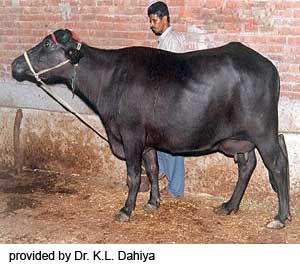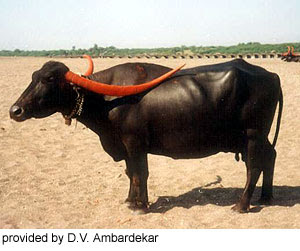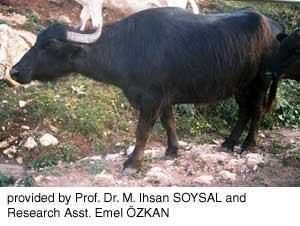

Murrah
Murrah breed of buffalo, the pride of Haryana, is a milk type animal. The home tract of Murrah buffalo is Rohtak, Jind and Hisar districts of Haryana (India). It is also found in Nabha and Patiala districts of Punjab (India) and around Delhi .
The physical characters of Murrah
Body : Sound built, heavy and wedge shaped.
Head : Comparatively small.
Face : Comparatively long.
Neck : Comparatively long.
Body colour : Jet-black.
White markings on face and leg extremities may be there (2, 3), but are not generally preferred.
Eyes : Should not be walled i.e. the cornea should not have whiteness.
Tail : Long reaching upto fetlock joint (2, 3, and 6) with black or white switch upto (maximum) 8.0 inches (4).
Horns : Different from other breeds of buffaloes; short, tight, turning backward and upward and finally spirally curving inward. The horns should be somewhat flattened. As the age advances the horns get loosened slightly but spiral curves increases.
Limbs : Comparatively short but strong built.
Skin : Soft, smooth with scanty hairs as compared to other buffaloes.
Udder : Fully developed, drooping.
Teats : Equally distributed over the udder but hind teats are longer than fore teats.
Loin : Broader and sliding forward.
Body weight : The average body weight of males, 550 Kg and the females, 450-Kg.
Height : The average height at withers; male: 1.42 meter; female: 1.32 meter.
Age at fist calving : 3 years but we have also the buffaloes, which calved at 3 years with good milk production.
Inter-calving period : 400 to 500 days.
Lactation period : 300 days. (with minimum of ~230 days recorded under top quality Murrah)
Daily lactation in peak period : 14 to 15 litter but upto 31.5 Kg milk production had also been recorded. The elite Murrah buffalo produces above 18-litter milk per day. A peak milk yield of 31.5 kg in a day has been recorded from a champion Murrah buffalo in the All India Milk Yield Competition conducted by the Government of India.
Dry period : About three months. But less than three may be there.
Gestation period : 310 days (average)
The Murrah buffalo is good milk producer, not only in India but also probably in the world (2, 7). The bulls of this breed are extensively used to upgrade the non-descript buffalo stock.
The Govt. Haryana ( India ) had launched an incentive cash prize for farmers to expand export of Murrah buffaloes.
References :
Parihar, M.L.; 'Major Buffalo Breeds of India' Pashudhan (Hindi), Vol. 16 No. 01, page 6
Banerjee, G.C.; "Animal Husbandary" 7th ed. (reprited, 1996), p. 10 5 . Published by Oxford & IBH Publishing Co. Pvt. Ltd.
H andbook of Animal Husbandary" 2nd (revised) ed. July 1990, p. 11. published by I.C.A.R., New Delhi.
' Performance Recording Programme – Grant of Incentive', Letter No. 2645-63 HLDB-1, dated 14/08/2003 from the Director, Animal Husbandry, Haryana; and Dairying-cum-Managing Director, Haryana Livestock Development Board, Chandigarh to all the Deputy Directors etc.
The Water Buffalo: New Prospects For An Underutilized Animal (1984)
Ashwani Sharma and Tantia M.S., 'THE BUFFALO: A valuable genetic resource that needs more attention' Livestock International, Vol. 3 No. 3 (March 1999) p. 9.
Dr. Daya Singh and Dr. Ziley Singh Rana, 'Principles of Animal Breeding' (PASHU PARJANAN KE SINDHANT) 1 ST edition (1991) p. 234.
Provider:
Dr. K.L. Dahiya, Veterinary Surgeon, Regional Artificial Insemination Centre, Shahzadpur (Ambala)
Photographs:
Dr. K.L. Dahiya, Veterinary Surgeon, Regional Artificial Insemination Centre, Shahzadpur (Ambala)











